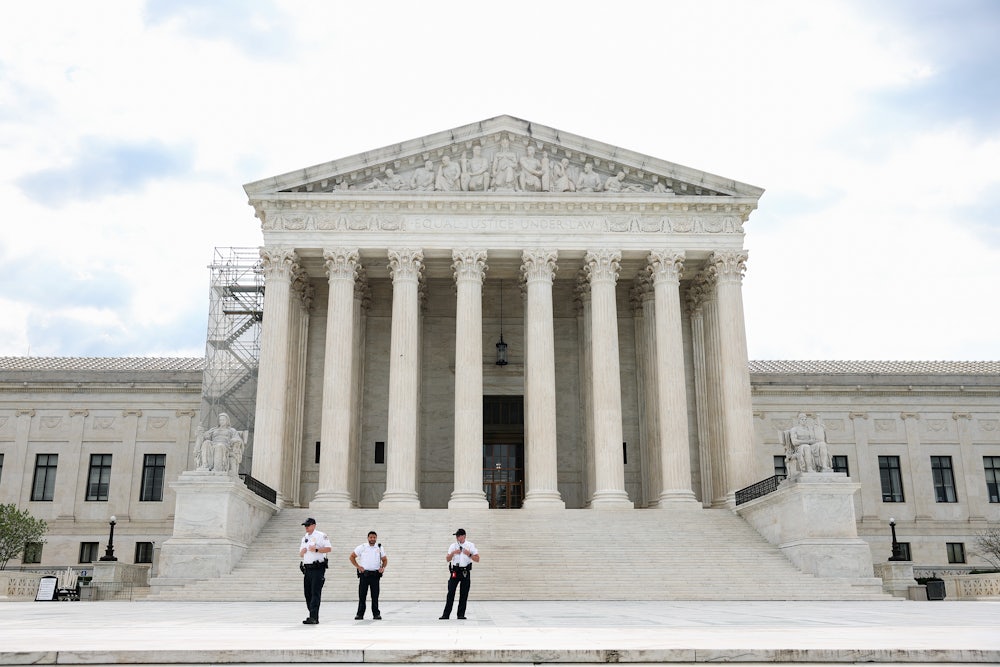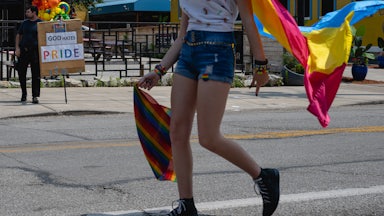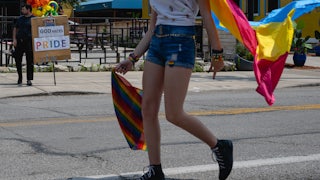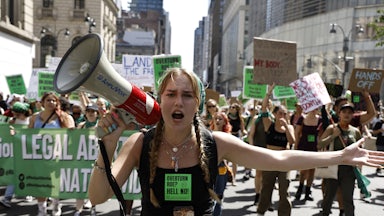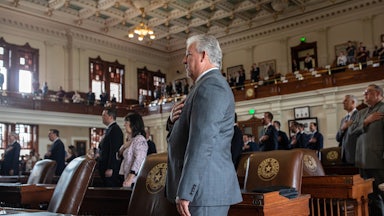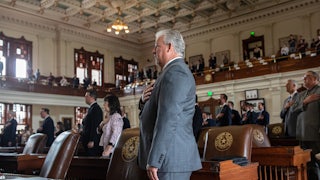Long before the Supreme Court took up one of the last remaining cases it will decide this session—the 303 Creative v. Elenis case, concerning a Colorado web designer named Lorie Smith who refuses to make websites for same-sex weddings and seeks an exemption from anti-discrimination laws—there was a couple named Stewart and Mike. According to court filings from the plaintiff, Stewart contacted Smith in September 2016 about his wedding to Mike “early next year.” He wrote that they “would love some design work done for our invites, placenames etc. We might also stretch to a website.” Stewart included his phone number, email address, and the URL of his own website—he was a designer too, the site showed.
This week, I decided to call Stewart and ask him about his inquiry.
The Supreme Court is expected to deliver its opinion in a case in which Stewart plays a minor role, a case that could be, as Justice Sonia Sotomayor stated by way of a question at oral argument in December, “the first time in the Court’s history … [that] a commercial business open to the public, serving the public, that it could refuse to serve a customer based on race, sex, religion, or sexual orientation.” (Update: On Friday, the court ruled 6-3 in the web designer’s favor.) It took just a few minutes to reach him. I assumed at least some reporters over the years had contacted him about his website inquiry to 303 Creative—his contact information wasn’t redacted in the filing. But my call, he said, was “the very first time I’ve heard of it.”
Yes, that was his name, phone number, email address, and website on the inquiry form. But he never sent this form, he said, and at the time it was sent, he was married to a woman. “If somebody’s pulled my information, as some kind of supporting information or documentation, somebody’s falsified that,” Stewart explained. (Stewart’s last name is not included in the filing, so we will be referring to him by his first name throughout this story.)
“I wouldn’t want anybody to … make me a wedding website?” he continued, sounding a bit puzzled but good-natured about the whole thing. “I’m married, I have a child—I’m not really sure where that came from? But somebody’s using false information in a Supreme Court filing document.”
Here is what we know—though, to be frank, I do not know what we have learned from this yearslong mystery, other than it looks like Smith and her attorneys have, perhaps unwittingly, invented a gay couple in need of a wedding website in a case in which they argue that same-sex marriages are “false.”
When Smith and her attorneys, the Christian right group Alliance Defending Freedom, or ADF, brought this case for the first time, it was to the United States District Court in Colorado in 2016, and they lost. Smith and ADF filed the case on September 20 of that year, asking the court to enjoin the state anti-discrimination law so that Smith could begin offering her wedding website design services to straight couples only. Up to this point, Smith had never designed any wedding website. (In fact, her website six months prior to the lawsuit being filed in 2016 does not include any of the Christian messaging that it did shortly afterward and today, archived versions of the site show.) The initial lawsuit did not mention the “Stewart” inquiry, which was submitted to Smith’s website on September 21, according to the date-stamp shown in later court filings, indicating that she received it the day after the suit was originally filed.
It is unclear exactly when—or if—the inquiry from “Stewart” was examined and verified in the course of this legal battle. (His phone number was, after all, right there.) In a motion filed by the defense on October 19, 2016, arguing that the case should be dismissed, they state that Smith has received no actual inquiries for services and therefore has suffered no injury. The following month, in its response, ADF did not mention the September 2016 “Stewart” inquiry to refute the defense’s claims. Rather, ADF merely stated that it was not necessary for Smith to have received an inquiry in order to challenge the law over her feared consequences of denying services to a same-sex couple.
Not until February 2017 did ADF include the text of the “Stewart” inquiry and argue its relevance to the case. “Notably, any claim that Lorie will never receive a request to create a custom website celebrating a same-sex ceremony is no longer legitimate because Lorie has received such a request,” the group wrote. “Even though she is not currently in the wedding industry, Lorie received an email inquiry on September 21, 2016.” Smith elaborated in a sworn statement that she “received a request through the ‘contact’ webpage on my website from a person named, ‘Stewart,’ reference number 9741406, to create graphic designs for invitations and other materials for a same-sex wedding (‘same-sex wedding request’).” She added that a “true and accurate copy” of the “same-sex wedding request” would be submitted with the statement. Why it took until possibly February 2017 to introduce the inquiry is not clear.
Whatever value the inquiry had, in September 2017, when the federal court ruled on the case, it seemed to dismiss it. The evidence presented as a whole, the ruling stated, did not allow the court to “determine the imminent likelihood that anyone, much less a same-sex couple, will request Plaintiff’s services.” Of the inquiry itself, the court said it was “too imprecise” and that “assuming it indicates a market for Plaintiff’s services, it is not clear that Stewart and Mike are a same-sex couple (as such names can be used by members of both sexes).”
ADF leapt on this. In response to its defeat, the group put out a press release claiming that “a federal judge ruled that Smith and her studio can’t sue to challenge a portion of Colorado’s Anti-Discrimination Act because a request sent to Smith by a couple, self-identified as ‘Stewart’ and ‘Mike,’ isn’t formal enough to prove that a same-sex couple has asked her to help them celebrate their wedding.” Their later appeal continued the theme, arguing that “according to Social Security Administration (SSA) data, only a nanoscopic number of women have been named Stewart or Mike since 1880. Lorie faces a 16 times greater chance of being struck by lightning than either name being female.”
All that may be true. But speedier, perhaps, than consulting SSA data would have been picking up the phone. According to Stewart, no one did until 2023, when I reached him.
“I’m not really sure where that came from,” he told me of the mysterious 2016 inquiry that used his name, email address, and cell phone number to request a wedding website for a same-sex marriage nearly a decade after he married a woman. He is a designer himself, something of a known quantity in design circles—he’s spoken at conferences and on podcasts, and has a “decent Twitter following,” he said. The design world is small. But not small enough, he said, that he had heard of Lorie Smith—not until her case was already before the Supreme Court, and the design community began discussing its potential fallout.
It didn’t make sense to him, he told me later via text message. Why would a web designer—as the website the inquiry referenced as his own made clear that he was—living in San Francisco, seek to hire someone in another state who has never built a wedding website, let alone a website for a same-sex wedding, to build his wedding website?
I don’t live inside Stewart’s computer—there’s a chance that he’s not telling me the whole story; that this is some elaborate prank he pulled years ago and doesn’t want to confess to now. But if he’s telling the truth—that this request was done completely without his knowledge—I don’t have any answers for him. None of this makes sense to me. And neither Lorie Smith nor ADF have responded to my inquiries. As late as 2020, ADF was maintaining that Stewart’s was a genuine inquiry. Speaking to “requests” for Smith’s services in a filing to the Tenth Circuit Court of Appeals, their attorneys wrote, “Lorie already received one. A prospective customer named ‘Stewart’ contacted Lorie through her webpage, asking about custom graphics and a website to celebrate his wedding to his fiancé, ‘Mike.’”
Maybe it should not be a surprise, though, that this strange fake “request” popped up in a case in which the plaintiff’s main argument rested on the claim that someday, out there, a same-sex couple would want her to design a wedding website. The closest thing Smith had to an actual inquiry—the nonwedding of Stewart and Mike—arrived within 24 hours of her having filed a suit in which said inquiry would be potentially a helpful piece of supporting evidence. The inquiry floats through the filings only later, and still it remains. Despite the district court raising doubts about it representing a genuine inquiry from two men getting married—and the court didn’t even raise the real doubt that the couple does not exist—it is now part of the case history, a bit of fan fiction joining the other phantom gays the case invokes. ADF made no mention of Stewart and Mike specifically in their arguments before the Supreme Court this session, but they don’t need to: Their entire case, after all, is built around the idea of gay people doing something that they have not yet done, nor ever will do.
Despite its flimsiness, the “Stewart” inquiry remains there in the 303 Creative court filings submitted to the Supreme Court, part of a raft of exhibits including mock-ups of websites Smith claims she was prevented from making by Colorado’s law protecting people from discrimination based on sexual orientation. “I disagree with this, in the strongest possible terms,” Stewart told me. “I couldn’t disagree with her stance more.” And while he wants nothing to do with the spotlight of this case, he does want it to be known: He never asked for a website, let alone what may result.
